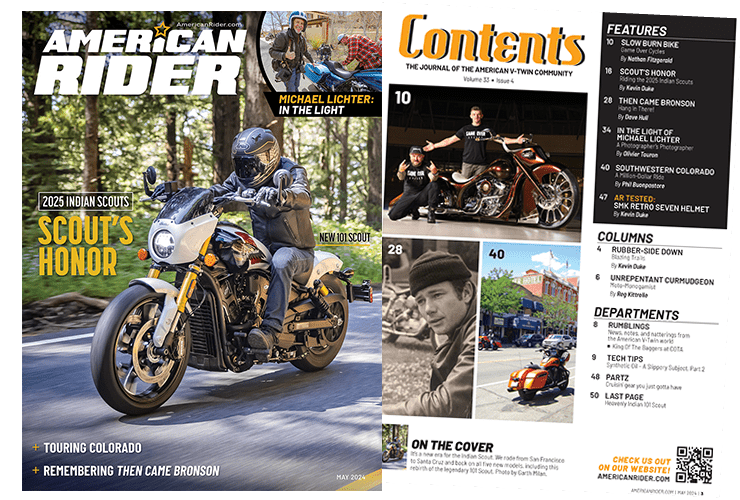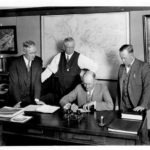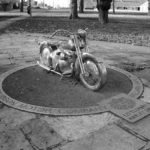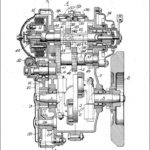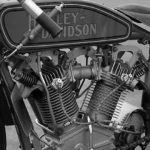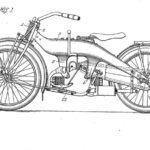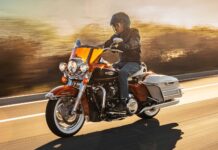If you don’t know where you came from, you can’t know where you’re going.
I enjoy studying the time when the slide rule ruled, solutions to problems and any improvements or innovations had to be thought up and tested—not merely spewed out of a CAD/CAM program to be slapped together and sold. Granted, the resulting machines of our forefathers weren’t as user-friendly as the ones to which we’ve become accustomed, but that’s not the point. You have to start somewhere and when motorcycles got started there was no other way, yet they persisted and developed, against heavy odds, until the digital age took over. I’m not one who thinks we should toss progress in favor of nostalgia, because nostalgia has a way of letting you down, on the road and in reality. I’m simply saying we’ve come a long way and I look forward to the next step as much as the next person. Thing is, I also look back and admire the kind of hot temperament and cold logic it took to get us this far. I regret more of us do not, because they are missing out on an essential understanding of the trajectory of technology though history. We, and our machines, are what we are today because of what these pioneers did yesterday… Know what I mean?
In a nutshell, as cool as the latest thing might be, as I get older, I’m more a fan of the days when men were men—and designed motorcycles. To name a specific example of a man (who tends to get short-shrift for his contributions in this department) I’d like to mention The Motor Company’s first chief engineer and a man who earned the title like few others… William S. Harley.
William Harley and Arthur Davidson were childhood friends who loved fishing, but hated the amount of time it took to get to their favorite fishing spots. Contrary to the legend, there’s ample evidence that the objective at the time was to build a powered boat, not a motorized bicycle… sorta like their friend Oly Evinrude. Flash forward a wee bit past 1901, and the fruits of their labor, in fact, turned out to be an underpowered motorized bicycle. Not good enough. A couple of years later, as the story goes, Bill had it figured out and the first Harley-Davidson motorcycle was created (with Art’s help). The so-called loop frame and robust 405cc single-cylinder engine was what separated this machine from even the most advanced contemporaries, like Indian, most of whom had stuck with bicycle-based diamond frames and smaller, less powerful engine designs. Sturdy, simple and silent about covers it. It was a start, but William S. Harley knew damn good and well that was all it was! He was 23 years old.
His decision to get the education he needed to go with his enthusiasm for doing his best with the bikes that bore his name can only be applauded. It was no free ride and during the course of his pursuit of a degree in engineering, the man had to pay as he went, waiting tables and doing other menial jobs to get along. It was worth it.
William Sylvester Harley was the only one of the founders who was born in America (the Davidsons were Scottish) and the only one with a degree in anything. This is not to take away from the contributions of the others, but to put Bill’s achievements in perspective. He was not an innovator, but was largely a developmental perfectionist within his scope. He didn’t, for example, invent the clutch, but realized he needed one for his motorcycles, so he designed one of the best and most durable of its era. That insight tells you a lot about him. He was not really a guy who did things to sell more machines to others, but a guy who made machines bearing his name better, because he liked to ride ’em, too! To me, it makes all the difference. His attitude and philosophy is a big chunk of the reason H-D survives today. That—and the fact he was a better engineer than he usually gets credit for.
No longer a boy wanting to go fishing—here (on the far left) is the man himself. At this point, he’s swapped fishing for golf and denim overalls for an uncharacteristically formal pinstripe suit!
One reason for the British connection might be this Model W Sport Twin, inspired by, but (as Bill’s patents prove) not—as is often believed—a copy of the British Douglas! Built from 1919 to 1923, it was a whole new ball game for H-D and a bike that deserved to succeed. What passed for market research right after the Great War, and curiously omitting the phenomenon of the Model T, said that folks would buy this kind of machine. Well, they didn’t buy this or very many Big Twins for that matter, since the action by that time was at the Ford dealers.
Sadly, aside from his machines, this is the only monument to William S. Harley anywhere in the world—and it’s in the village of Littleport in England.
As this drawing of the opposed twin engine indicates, by the time the factory was ready to introduce the Sport Twin, there were at least seven of Bill’s patents (#1263407, #1264642, #1266589, #1301256, #1301258, #1328150, #1360110) directly applied to this machine, several that might have been indirectly useful and even more that were “thunk up” but not used… mostly the chassis…
…which is shown here in patent #1510937 (“A Motorcycle”) and looks a lot like the so-called “pressed backbone” kind of frame that the Japanese used in the ‘60s—nearly 40 years later! This frame didn’t make it to the finished product (like the one in the other picture) but many an innovation of Bill’s did. In the end, although it would have been nice to do both—Harley (the man and the company) learned that if it comes down to a choice between selling a lot of cheap bikes for little profit or a few V-Twins for a reasonable one—the V-Twins win.
The patent (#1472068) this drawing of the 8-valve engine appears in is related directly to aluminum cylinders (in 1919!) but even a cursory examination of the details revealed tells you there was much more to what was neither a cheap engine nor a common one. There had already been, by this time, racing motorcycles sporting OHC layouts, like Cyclone and Excelsior, but none were as effective at the time as this one. Bill’s racing JDCA Special engine took over where the pre-war 8-valver’s left off—then simply took off—some 10 mph faster than anything else on the track! The Sport Twins and 8-valve racers alone, in my book, speak eloquently enough to his total “cred” as both engineer and—Honest to Pete—motorcyclist!
If designing practical little motorcycles was about creating the bread and butter machines for the early ’20s, then this is Grade A ultra-rare steak! In the era of (already) plenty potent J-series Big Twins for the “normal” street racer—Bill also cooked up a small batch of real (8-valve) race engines… for experts only!
If you need to be reminded or require some demonstrable proof of that fact, I’m glad to offer a smattering of it here, in the form of an examination of some of the more entertaining of his roughly 90 patents, granted over a period of nearly four decades… while the boy became “The Man.”
William S. Harley Patents
(For anyone wanting more details, PDF files of all these patents are available courtesy of Google Patent Search)
1910: USP# 946037—Motorcycle Prop Stand (Granddaddy of the center-stand, pivoting on the rear wheel)
1910: USP# 973426—Belt Tightener (A primitive way to “find neutral” before you got in gear)
1910: USP# 978880—Variable Gearing (Two-speed “tranny” in the rear wheel)
1910: USP# 978881—Sprung Frame (“Monoshock” rear suspen sion!—to go with the rear wheel transmission)
1910: USP# 979483—Spring Seat Post (In case the rear shock wasn’t enough or didn’t work out… hmmm?)
1910: USP# 979484—Lubricator System (A pretty advanced notion for a first shot at an oil pump)
1911: USP# 1001846—Silencer for Intake Valves (Really, a mechanism to slow down the banging onto the seat that atmospheric intakes were infamous for —“in the day”)
1912: USP# 1024684—Spring Seat Post (An improved version of #979483)
1912: USP# 1024685—Seat Support (A variation on #979483 and #1024684)
1912: USP# 1020199—Friction Clutch (Belts are going, chains are coming, this is a rear wheel “clutch” to replace the belt tightener of 1910)
1913: USP# 1062003—Stand Latch for Motorcycles (A big old spring-loaded clip on the rear fender, to keep the “motorcycle prop stand” from falling onto the road)
1913: USP# 1068583—Frame for Motor Cycles or Like Vehicles (Yet another version of the sprung frame, this time with the spring up the frame backbone!)
1913: USP# 1070462—Variable Speed Gearing (A two-speed planetary gearbox, located in the rear wheel hub)
1914: USP# 1089128—Internal Combustion Engine of the Compression Type (This is a still-born “sleeve-valve” type engine, which eliminated conventional poppet valves)
1914: USP# 1090532—Motorcycle Oil Tank (Which became the left half of the gas tank, as old-timers will recall)
1914: USP# 1092910—Three Wheel Truck (Not the Servi-car, this one has the “box” up front)
1914: USP# 1094558—Transmission Gearing for Motor Propelled Vehicles (… which, since they still had pedals, meant an improved gearbox in the back wheel)
1914: USP# 1097315—Engine (Improved rear cylinder oiling, actually. Damn clever!)
1914: USP# 1097546—Transmission Gearing (Sort of a two-speed front set-up to go with the two-speed rear set up)
1914: USP# 1103044—Bearing (Better, beefier bearing set-up for that rear axle clutch)
1914: USP# 1108904—Oil Distributing Mechanism (An adjustable oil “squirter,” another step closer to a modern oil pump)
1914: USP# 1116420—Footboard Attachment for Motorcycles (As you’d imagine, except the part about being detachable for shipping and installation by amateurs)
1914: USP# 1122388—Muffler (A cheaper, more silent muffler for the bikes that followed the “Silent Gray Fellow”)
1915: USP# 1137134—Transmission Gearing (Seems to be like #1097546, but for belt drive applications)
1915: USP# 1137314—Engine Starter (A spring-loaded, pull-cord design, not that different from the one on your old lawnmower)
1916: USP# 1184344—Compression Reliever for Crank Cases (A rotary valve set-up designed to make starting easier)
1916: USP# 118345—Motor Starter (Harley liked to call it a “step starter,” but we call it a kick starter)
1916: USP# D49820—Motor Cycle Frame (A design patent for what Bill himself refers to as “ornamental” frame, oil tank, and gas tank, looking a lot like every Harley built in the pre-World War I era)
1916: USP# 1203612—Interchangeable Wheel Hub (Just what it sounds like, front, back and for sidecars too… s’all the same!)
1916: USP# D49963—Vehicle Body (Actually a sidecar body design, almost as familiar to fans of the pre-war H-D’s as the motorcycle)
1917: USP# D50129—Gear Wheel (A cool little “H-D” pattern cut into the front pedal crank, when Harleys still had pedals)
1917: USP# 1212350—Sidecar for Motor Cycles (Really, the three point mounting system with ball joints, no less!)
1917: USP# 1216686—Shock Absorber (A clever friction type, for sidecars)
1917: USP# 1240442—Circuit Breaker (Actually a complex, vacuum-based gadget to keep points open when the engine wasn’t running—to save the battery)
1917: USP# 1243165—Pedal (In this case the novel folding kick start pedal)
1917: USP# 1247829—Transmission Gear (All the “gear”… foot clutch, tank shifter, gearbox behind the engine, as it was to be until 1952)
1918: USP# 1254798—Spring Motor Cycle Fork (Not the normal Springer fork—see below)
1918: USP# 1254799—Oil Distributing Mechanism (Okay, a real pressurized oil pump, but with no provision for return—only feed)
1918: USP# 1262785—Side Car for Motor Cycles (Now, he puts leaf spring suspension under the chassis)
1918: USP# 1262786—Cycle Frame (A sheet metal arrangement for the rear swing arm, rather than tubing)
1918: USP# 1262787—Shock Absorber for Handle Bars (NOT—rubber bushings in risers! This is real attempt at quelling the considerable vibes in the handlebars)
1918: USP# 1263236—Vehicle Frame (Mostly, this is about single-sheet stamping of frame components)
1918: USP# 1263407—Counterbalanced Crank Shaft (Not for a V-Twin! See picture)
1918: USP# 1264642—Flywheel (Stamped—with riveted in, rather than cast-in weights)
1918: USP# 1264643—Front Fork Construction (Another stamped steel notion, this one for the front forks)
1918: USP# 1266589—Motor Cycle Frame (Not for a V-Twin! See picture)
1918: USP# 1266800—Spring Frame for Motor Cycles & Like Vehicles (Yet another shot at rear suspension—this time with an elliptic leaf spring)
1919: USP# 1293643—Motor Cycle Frame Structure for V-Type Motors (A bolted-up sheet metal design, arguably motivated by the first World War, as a way to supply frames without trained welders or brazing)
1919: USP# D53150—Motor Cycle Frame (A “design” patent that combined all the sheet metal chassis components into one complete package)
1919: USP# 1301256—Compression Relieving Mechanism (Not for a V-Twin! See picture)
1919: USP# 1301257—Side Car Body Method (These things were bulky—the invention is a “knock-down,” easy to assemble multi-piece chair body, which could be shipped anywhere)
1919: USP# 1301258—Motor Cycle Lubrication System (Not for a V-Twin! See picture)
1919: USP# 1308239—Case Hardening Materials (Another possible reflection on the need for war materials in a hurry—but the “recipe” is intriguing and useful all the same)
1919: USP# 1319332—Magneto Circuit Breaker (1) (A way to automatically disconnect the mag from the battery to prevent discharges)
1919: USP# 1325016—Magneto Circuit Breaker (2) (What appears to be an early attempt at an automatic timing advance)
1920: USP# 1328149—Automatic Voltage Control (Via centrifugal bob-weights)
1920: USP# 1328150—Combined Intake and Exhaust Manifold (Not for a V-Twin! See picture)
1920: USP# 1360110—Engine Construction (Not a for a V-Twin! See picture)
1920: USP# 1360945—Motorcycle Windshield (Simple as that… and canvas!)
1923: USP# 1459671—Distributor Cap or the Like (Mostly waterproof, fool-proof and quick attach/detach)
1923: USP# 1469594—Rivet Remover (What we would call a chain breaker!)
1923: USP# 1472068—Engine (Definitely for a V-Twin! A very special one! See picture)
1924: USP# 1485353—Ignition Apparatus (This is the timer/distributor set up we’ve seen on almost any old Harley without a magneto)
1924: USP# 1494784—Hub Bearing (Heavy duty and engineered to control thrust, and lateral loads while maintaining alignment on the axle under any/all loads)
1924: USP# 1505335—Brake (Nothing special, other than it was designed to be quick detach/attach! An add-on, I’m guessing, for guys who dirt raced their street bike—or vice-versa?)
1924: USP# 1510937—A Motor Cycle (And how! See picture)
1924: USP# 1513170—Cooling Means for Internal Combustion Engines (Really, a sort of thin, gasket-like, “fin” insert between head and barrel on flatheads)
1925: USP# 1527133—Shock Absorber (This time, a Springer that’s tubular and has extra springs inside the tubes. Arguably, an attempt to tame “speed wobbles” as Harleys hit 100 mph)
1925: USP# 1549976—Disk Clutch (Finally—tranny shaft mounted and much like the clutch used until 1984)
1925: USP# 1553610—Lamp Bracket (A coiled wire type of taillight mount intended to keep the bulb from vibrating into darkness)
1925: USP# 1562555—Aluminum Cylinder (A composite design with an advanced type of interlock between steel liner and alloy outer casting)
1926: USP# 1587724—Power Impulse Equalizer (An early attempt at what we’d call today a “compensator”)
1926: USP# 1594615—Spring Suspension for Vehicles (with Arthur Constantine) (Sidecar suspension—revisited)
1926: USP# 1595232—Electric Switch (Ignition switch; to be precise, the one found on the gas tank of Big Twins)
1926: USP# 1603596—Hub Protector (What we now call “dust shields” for wheel bearings)
1926: USP# 1604349—Distributor Cap (This time for the “timer” type, not a magneto, and designed to let water pass through without getting the points wet)
1926: USP# 1611908—Storage Battery (with George Appel) (A design to keep engine vibration from knocking the plates to pieces)
1928: USP# 1675551—Cycle Support (with Arthur Constantine) (That’s “jiffy stand” to us!)
1930: USP# 1761038—Pump (In this case a throttle controlled variable supply oil pump intended to match oil feed requirements with engine load)
1931: USP# 1834308—Motor Cycle Front Fork Assembly (The heavy-duty brazed, “I”-beam Springer design)
1932: USP# 1850348—Steering Damper (Springs, friction discs and a big ol’ lever)
1934: USP# 1941801—Motorcycle Protecting Guard (Front crash bar to the politically incorrect—engine guard to the rest)
1934: USP# 1961145—Motorcycle Saddle Structure (with Frank Trispel) (The “Full-Floting” seat, with spring post and booster springs)
1937: USP# 2091682—Instrument Mounting for Motorcycles (The “catseye” dash and ancestor to any tank-mounted instrument clusters)
1938: USP# 2109315—Radio Carrying Attachment for Bicycles and Motorcycles (All the bulky police radio equipment of the day—stuffed into hard saddlebags)
1938: USP# 2109316—Oil Tank and Battery Assembly (The under-the-seat set-up now known as the “horseshoe” tank)
1938: USP# 2111242—Lubricating System for Internal Combustion Engines (Timed breather gear and pump assembly—as it was to be from 1936 to 1999)
1939: USP# 2180521—Piston (Aluminum to be precise, and using a cast-in steel “bridge” to keep it round under fire… used until the Evolution engines appeared)

